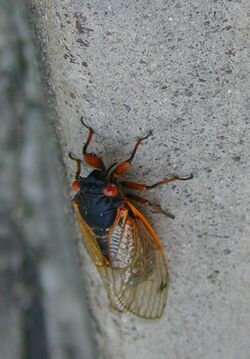Biology:Cicadomorpha
| Cicadomorpha Temporal range: Upper Permian to Holocene
| |
|---|---|

| |
| A Magicicada species cicada | |
| Scientific classification | |
| Domain: | Eukaryota |
| Kingdom: | Animalia |
| Phylum: | Arthropoda |
| Class: | Insecta |
| Order: | Hemiptera |
| Suborder: | Auchenorrhyncha |
| Infraorder: | Cicadomorpha Evans, 1946 |
| Extant superfamilies | |
| Synonyms | |
|
Clypeorrhyncha Sorensen et al., 1995 | |
Cicadomorpha[1] is an infraorder of the insect order Hemiptera which contains the cicadas, leafhoppers, treehoppers, and spittlebugs. There are approximately 35,000 described species worldwide. Distributed worldwide, all members of this group are plant-feeders, and many produce either audible sounds or substrate vibrations as a form of communication. The earliest fossils of cicadomorphs first appear during the Late Permian.
Classification
Some authors use the name Clypeorrhyncha (from the Latin clypeus and the Greek ῥύγχος rhúnkhos, 'shielded nose') as a replacement for the extant Cicadomorpha.[2] Nymphs of many Cicadomorphans coat themselves with secretions from specialized Malphigian tubules. They are never coated with hydrophobic wax as seen in the nymphs of Fulgoromorpha. Most Cicadomorphas have a filter chamber in their mid-gut which helps remove excess water from the xylem or phloem sap that they feed on.[3]
Of the three extant superfamilies within the Cicadomorpha, molecular phylogeny studies have placed Membracoidea as a sister group to a clade containing Cicadoidea and Cercopoidea. Within these superfamilies, not all deep phylogeny questions have been resolved.[4]
Modified after Szwedo, 2018.[5]
- †Infraorder Prosbolopsemorpha Szwedo, 2018
- Superfamily † Prosbolopseoidea Becker-Migdisova, 1946
- Family † Prosbolopseidae Becker-Migdisova, 1946 (Permian)
- Superfamily † Pereborioidea Zalessky, 1930
- † Curvicubitidae Hong, 1984 (Triassic)
- † Ignotalidae Riek, 1973 (Permian-Triassic)
- † Pereboriidae Zalessky, 1930 (Permian-Triassic)
- Superfamily †Dysmorphoptiloidea Handlirsch, 1906
- †Dysmorphoptilidae Handlirsch, 1906 (Permian- Jurassic)
- †Eoscarterellidae Evans, 1956 (Permian-Triassic)
- †Magnacicadiidae Hong & Chen, 1981 (Triassic)
- Superfamily † Palaeontinoidea Handlirsch, 1906
- † Dunstaniidae Tillyard, 1916 (Permian–Jurassic)
- † Mesogereonidae Tillyard, 1921 (Triassic)
- † Palaeontinidae Handlirsch, 1906 (Triassic–Cretaceous)
- Superfamily † Hylicelloidea Evans, 1956
- † Chiliocyclidae Evans, 1956; Triassic
- † Hylicellidae Evans, 1956 (Triassic–Cretaceous)
- † Mesojabloniidae Storozhenko, 1992 (Triassic)
- Superfamily † Prosbolopseoidea Becker-Migdisova, 1946
- Clade Clypeata Qadri, 1967
- Superfamily Cercopoidea Westwood, 1838
- Superfamily Cicadoidea Latreille, 1802
- Superfamily †Hylicelloidea Evans, 1956
- † Chiliocyclidae Evans, 1956; Triassic
- † Hylicellidae Evans, 1956 (Triassic–Cretaceous)
- † Mesojabloniidae Storozhenko, 1992 (Triassic)
- † Minlagerrontidae Chen, Szwedo and Wang, 2019 (Cretaceous)
- Superfamily Membracoidea Rafinesque, 1815
References
- ↑ Evans JW (1946) A natural classification of leaf-hoppers (Jassoidea, Homoptera). Part 1. External morphology and systematic position. Transactions of the Royal Entomological Society of London 96 (3): 47–60.
- ↑ Sorensen, J. T.; Campbell, B. C.; Gill, R. J.; Steffen-Campbell, J. D. (1995). "Non-monophyly of Auchenorrhyncha ("Homoptera"), based upon 18S rDNA phylogeny: eco-evolutionary and cladistic implications within pre-Heteropterodea Hemiptera (S. L.) and a proposal for new monophyletic suborders". The Pan-Pacific Entomologist 71 (1): 31–60.
- ↑ C. H. Dietrich in Resh, V. H. & Carde, R. T. (Eds.) 2003 Encyclopedia of Insects. Academic Press.
- ↑ Cryan, Jason R. (2005). "Molecular phylogeny of Cicadomorpha (Insecta: Hemiptera: Cicadoidea, Cercopoidea and Membracoidea): adding evidence to the controversy". Systematic Entomology 30 (4): 563–574. doi:10.1111/j.1365-3113.2004.00285.x.
- ↑ Szwedo, Jacek (June 2016). "The unity, diversity and conformity of bugs (Hemiptera) through time" (in en). Earth and Environmental Science Transactions of the Royal Society of Edinburgh 107 (2-3): 109–128. doi:10.1017/S175569101700038X. ISSN 1755-6910. https://www.cambridge.org/core/product/identifier/S175569101700038X/type/journal_article.
Wikidata ☰ Q634988 entry
 |

